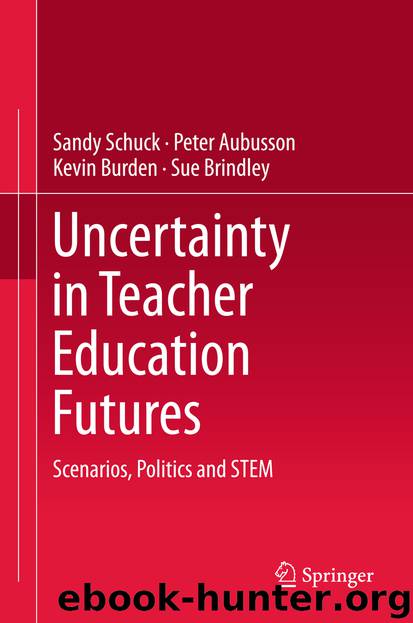Uncertainty in Teacher Education Futures by Sandy Schuck Peter Aubusson Kevin Burden & Sue Brindley

Author:Sandy Schuck, Peter Aubusson, Kevin Burden & Sue Brindley
Language: eng
Format: epub
Publisher: Springer Singapore, Singapore
Keywords
OECD scenariosLearning systemsSchooling scenariosTeacher educationFutures researchEducational drivers
Introduction
A starting point for our investigation of education through scenarios was a set of scenarios for schooling proposed by the Organisation for Economic Co-operation and Development’s Centre for Educational Research and Innovation in their book What schools for the Future? (CERI/OECD, 2001, 77–98). The book analysed the social, economic and educational trends that were influential in directing the nature of schooling and extrapolated from these trends or drivers to imagine a set of six scenarios projected to describe schooling in 15–20 years from the time of their development. These scenarios encompassed different ideas about schooling that the CERI/OECD (2001) group developed as a stimulus to start discussions and encourage debate and discussion about the directions of schooling. The authors of the scenarios noted that they are presented as extremes that are deliberately provocative and often uncomfortable, to gain attention and stimulate discussion. It is noteworthy that these scenarios were not necessarily presented as positive but often portrayed a negative and sometimes shocking picture. This is in contrast to the methodology used in this book in all other chapters (see, for example, Chap. 7), where one of the criteria for scenario development was that the future events in scenarios were portrayed as positive and as having a benefit to that scenario’s stakeholders.
Schuck and Aubusson (2010) discussed the OECD scenarios a decade after they were developed, to see how they might align with trends in a digital world dominated by Web 2.0 applications and use. They considered each of the scenarios and contemplated what the possible impact of a world in which social media was thriving might have on each of them. An alternative set of scenarios was developed that considered how learning might be impacted by the dominance of Web 2.0, a development of the World Wide Web that encouraged interactivity and collaboration.
Given that we are now in the period in which the original OECD scenarios were supposed to be located, it may be instructive to see how our current present aligns with the futures outlined in these scenarios. In this chapter, we revisit these scenarios and consider their use as descriptions of school in the late years of the second decade of the twenty-first century, that is, approximately 17 years after they were first developed. Given that the scenarios were speculations about how schooling might be in about 20 years’ time, it is interesting to see what we recognise in them of schooling today. The current context is then examined for the implications of these scenarios for teacher education. Finally, we look at how the OECD scenarios might be modified to act as scenarios of schooling in the 2030s, using some of the drivers that exist in the current context to construct the new versions.
Download
This site does not store any files on its server. We only index and link to content provided by other sites. Please contact the content providers to delete copyright contents if any and email us, we'll remove relevant links or contents immediately.
The Motivation Myth by Jeff Haden(5116)
Audition by Ryu Murakami(4761)
Adulting by Kelly Williams Brown(4429)
The Confidence Code by Katty Kay(4147)
A Mind For Numbers: How to Excel at Math and Science (Even If You Flunked Algebra) by Barbara Oakley(3179)
Waiting in the Wings by Melissa Brayden(3143)
Self-Esteem by Matthew McKay & Patrick Fanning(3029)
Nice Girls Don't Get the Corner Office by Lois P. Frankel(2966)
Fooled by Randomness: The Hidden Role of Chance in Life and in the Markets by Nassim Nicholas Taleb(2964)
The ONE Thing by Gary Keller(2957)
The Dictionary of Body Language by Joe Navarro(2872)
How to be More Interesting by Edward De Bono(2711)
Designing Your Life by Bill Burnett(2618)
Getting Things Done by David Allen(2610)
The Plant Paradox by Dr. Steven R. Gundry M.D(2504)
Police Exams Prep 2018-2019 by Kaplan Test Prep(2438)
What Color Is Your Parachute? 2015 by Richard N. Bolles(2223)
Dangerous Personalities by Joe Navarro(2201)
When to Jump by Mike Lewis(2068)
